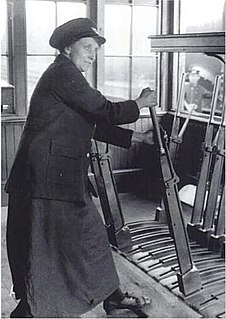A private is a soldier of the lowest military rank.
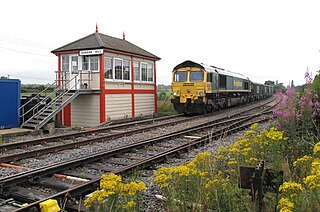
On a rail transport system, signalling control is the process by which control is exercised over train movements by way of railway signals and block systems to ensure that trains operate safely, over the correct route and to the proper timetable. Signalling control was originally exercised via a decentralised network of control points that were known by a variety of names including signal box, interlocking tower and signal cabin. Currently these decentralised systems are being consolidated into wide scale signalling centres or dispatch offices. Whatever the form, signalling control provides an interface between the human signal operator and the lineside signalling equipment. The technical apparatus used to control switches (points), signals and block systems is called interlocking.

The Quintinshill rail disaster was a multi-train rail crash which occurred on 22 May 1915 outside the Quintinshill signal box near Gretna Green in Dumfriesshire, Scotland. It resulted in the deaths of over 200 people, and is the worst rail disaster in British history.
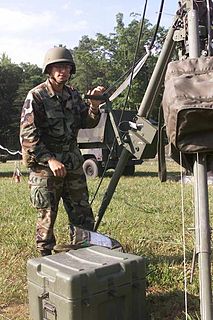
A signaller in the armed forces is a specialist soldier, seaman or airman responsible for military communications. Signallers, a.k.a. Combat Signallers or signalmen or women, are commonly employed as radio or telephone operators, relaying messages for field commanders at the front line, through a chain of command which includes field headquarters and ultimately governments and non government organisations. Messages are transmitted and received via a communications infrastructure comprising fixed and mobile installations.

The Invergowrie rail accident happened at Invergowrie, Scotland on 22 October 1979. The accident killed 5 people and injured 51 others.

The Hawes Junction rail crash occurred at 5.49 am on 24 December 1910, just north of the Lunds viaduct between Hawes Junction and Aisgill on the Midland Railway's Settle and Carlisle main line in Westmorland, England. It was caused when a busy signalman, Alfred Sutton, forgot about a pair of light engines waiting at his down (northbound) starting signal to return to their shed at Carlisle. They were still waiting there when the signalman set the road for the down Scotch express. When the signal cleared, the light engines set off in front of the express into the same block section. Since the light engines were travelling at low speed from a stand at Hawes Junction, and the following express was travelling at high speed, a collision was inevitable. The express caught the light engines just after Moorcock Tunnel near Aisgill summit in Mallerstang and was almost wholly derailed.

Absolute block signalling is a British signalling scheme designed to ensure the safe operation of a railway by allowing only one train to occupy a defined section of track (block) at any time. This system is used on double or multiple lines where use of each line is assigned a direction of travel.
The Thirsk rail crash happened at Manor House signal box on 2 November 1892, on the North Eastern Railway about 3 miles (4.8 km) north of Thirsk railway station in the North Riding of Yorkshire, England.
The Winwick rail crash took place at Winwick Junction, near Warrington on the London, Midland and Scottish Railway, on 28 September 1934. Two trains collided, resulting in 11 deaths and 19 injured.

Signalman is a fictional supervillain appearing in comic books published by DC Comics.
The Darlington rail accident occurred on the evening of 27 June 1928 when a parcels train and an excursion train collided head on at Darlington Bank Top railway station in County Durham, England. The accident was caused by the parcels train driver passing a signal at danger, due to misunderstanding the signalling layout in an unfamiliar part of the station. This accident resulted in the deaths of 25 people and the serious injury of 45 people.
The Connington South rail crash occurred on 5 March 1967 on the East Coast Main Line near the village of Conington, Huntingdonshire, England. Five passengers were killed and 18 were injured.
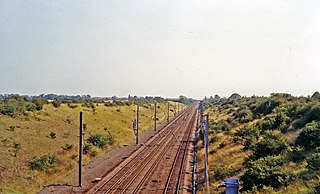
The Abbots Ripton rail disaster occurred on 21 January 1876 at Abbots Ripton, then in the county of Huntingdonshire, England, on the Great Northern Railway main line, previously thought to be exemplary for railway safety. In the accident, the Special Scotch Express train from Edinburgh to London was involved in a collision, during a blizzard, with a coal train. An express travelling in the other direction then ran into the wreckage. The initial accident was caused by:
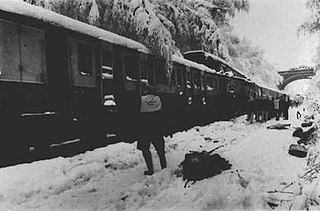
The Seer Green rail crash occurred on the morning of 11 December 1981 near Seer Green, Buckinghamshire, England between two four-car Class 115 diesel multiple units, killing one driver and three passengers.

The Knowle and Dorridge rail crash was a fatal rail crash that occurred at Dorridge railway station in the West Midlands, England, on 15 August 1963. Three people died in the crash after a signalman's error routed a small freight train into the path of an express passenger train which slowed but could not stop before colliding with it.

The Signalman is a 1976 BBC television adaptation of "The Signal-Man", an 1866 short story by Charles Dickens. The story was adapted by Andrew Davies as the BBC's sixth Ghost Story for Christmas, with Denholm Elliott starring as the signalman and Bernard Lloyd as the traveller, an unnamed character who acts as a plot device in place of the short story's narrator.
"Taxi Sense" was one of the many “Sense” manuals produced by the Aviation Training Division, Office of the Chief of Naval Operations, U.S. Navy for Navy Aviators. This particular manual was published in January 1944. The “Sense” manuals were published by the Aviation Training Division in order to supply the armed forces with readable training manuals. The manuals were meant to highlight common sense topics for Naval aviators. No artists or authors are credited explicitly within the manual. The training manuals were considered to be an inviting way to introduce their audience to the necessary material. The cover of the manual features a navy man holding a naval aircraft with a pilot inside, standing over a bunk. The back of the manual features a navy man with his eyes closed dreaming of a naked woman. His distraction is leading him straight into a running saw.
This page is based on this
Wikipedia article Text is available under the
CC BY-SA 4.0 license; additional terms may apply.
Images, videos and audio are available under their respective licenses.


